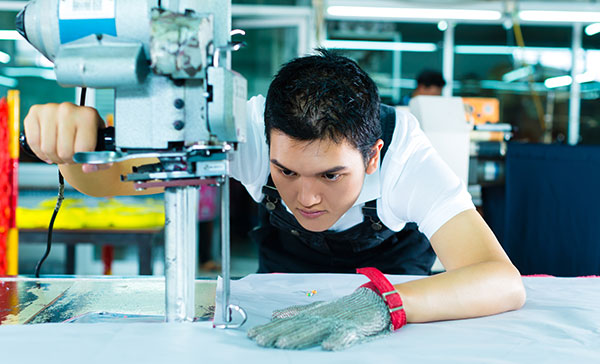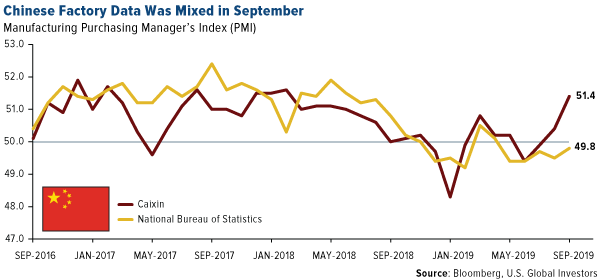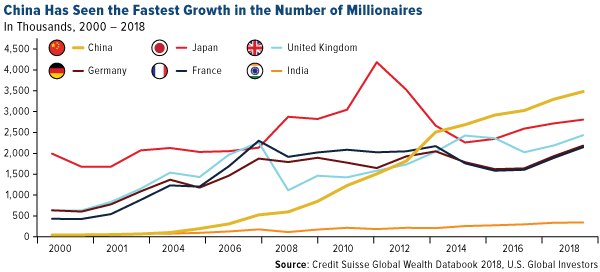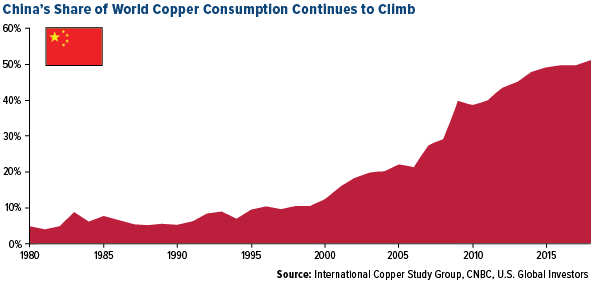
As the People’s Republic of China (PRC) celebrates its 70th anniversary, manufacturing data shows that factories in the world’s second largest economy improved marginally in September, despite the impact of the ongoing U.S.-China trade war.
According to the private Caixin reading, China’s manufacturing sector grew at its fastest pace since February 2018, with the purchasing manager’s index (PMI) rising to 51.4 in September from 50.4 the previous month. The “official” data, released by the country’s National Bureau of Statistics, was slightly less optimistic. Its PMI reading came in at 49.8. Although still in contraction mode, conditions are clearly heading in the right direction.
U.S. factories, by comparison, shrank at their fastest pace in more than 10 years in September. The ISM Manufacturing PMI fell to 47.8, lower than expectations and signaling a pullback for the second straight month.
“Global trade remains the most significant issue, as demonstrated by the contraction in new export orders that began in July 2019,” wrote Timothy Fiore, chair of the Institute for Supply Management (ISM), which issues the monthly business report.
For his part, President Donald Trump blamed the news of U.S. manufacturing weakness on the “pathetic” Federal Reserve, tweeting that “Jay Powell and the Federal Reserve have allowed the Dollar to get so strong, especially relative to ALL other currencies, that our manufacturers are being negatively affected. Fed Rate too high.”
U.S.-China Trade Truce Coming Sooner Rather Than Later?
 The outlook on a truce to the U.S.-China trade war is improving, even as the Trump White House is currently embroiled in an impeachment inquiry. That’s according to Andy Laperriere, head of U.S. policy research at Cornerstone Macro, who visited our office this week.
The outlook on a truce to the U.S.-China trade war is improving, even as the Trump White House is currently embroiled in an impeachment inquiry. That’s according to Andy Laperriere, head of U.S. policy research at Cornerstone Macro, who visited our office this week.
“We are probably getting close to the end of escalating tariffs with China,” Andy said. “The odds are growing a trade truce along the lines of what it appeared was achieved after the June G20 meeting: China buys some U.S. agriculture, and in return the U.S. provides relief for Huawei and delays scheduled tariff increases.”
Keep in mind that Andy is only suggesting a halt to any further tariff escalation, not a complete resolution. For a rollback to happen, Andy says, both sides will need to make a comprehensive agreement, with China willing to make “major structural reforms”—which is probably unlikely before the 2020 U.S. election.
Just as unlikely is Trump accepting a deal with “token Chinese concessions.” Such a deal would be a policy failure from the point of view of Trump, who has made trade a central issue in his presidency.
According to reports, trade talks are scheduled to take place October 10 and 11 in Washington.
The trade war remains the biggest risk to the Chinese economy, Cornerstone Macro said in a note this week, and as a “present” to the PRC for its 70th anniversary, Beijing has made as many as 100 “easing moves” over the past 14 months. These include tax cuts, regulation cuts, bank reserve requirements cuts and interest rate cuts.
Additional easing isn’t expected in the near term, though. The governor of China’s central bank, Yi Gang, stated recently that he was “not in a rush to roll out massive rate cuts or QE (quantitative easing) like some other central banks” are right now.
China at 70, Market Reforms at 41
The PRC may be 70 years old, but it only started on its path to becoming the global powerhouse that it is today only after major economic reforms were put into place by Deng Xiaoping in 1978. I’ve written about Deng a number of times before—as recently as last month, in fact, when China announced the creation of new free trade zones (FTZs).
More than 40 years ago, when Deng opened China’s economy up to the world in a series of reforms, the country was one of the poorest in the world. Today, thanks to those initial reforms, China is the second biggest economy on a dollar basis, the number one biggest when measured by purchasing power parity (PPP).
Over this period, the number of people who have graduated out of poverty into the middle class is unlike anything the world has ever seen. Last year it was reported that the Chinese economy was creating as many as two new billionaires per week. And since 2014, China surpassed Japan in the number of millionaires and today has the second most in the world following the U.S.
The growth in wealth has been nothing short of explosive. From 2000, when China had only 41,000 millionaires, the number has increased by a factor of 80 to reach the current level of 3.5 million millionaires, according to Credit Suisse.
“China’s influence across global commodity markets is without parallel,” analysts at Wood Mackenzie recently stated.
Indeed, the country has expanded to become the world’s largest consumer of a number of important commodities, from soybeans to copper to steel. Today, China uses about half of all copper that’s processed all around the globe. That’s up significantly from its 10 percent in 1980, soon after Deng’s reforms went into effect.
It should surprise no one to hear that many challenges lie ahead for China—not least of which is the trade war with the U.S. Nevertheless, I’m optimistic and still of the opinion that it remains one of the best places to invest.
Curious to learn more? Check out our slideshow, “How China Became a Capitalist Nation,” by clicking here!
All opinions expressed and data provided are subject to change without notice. Some of these opinions may not be appropriate to every investor.
The Purchasing Manager’s Index is an indicator of the economic health of the manufacturing sector. The PMI index is based on five major indicators: new orders, inventory levels, production, supplier deliveries and the employment environment. The Caixin China General Manufacturing Purchasing Managers’ Index (PMI) is closely watched by investors as one of the first available indicators every month of the strength of the Chinese economy.



